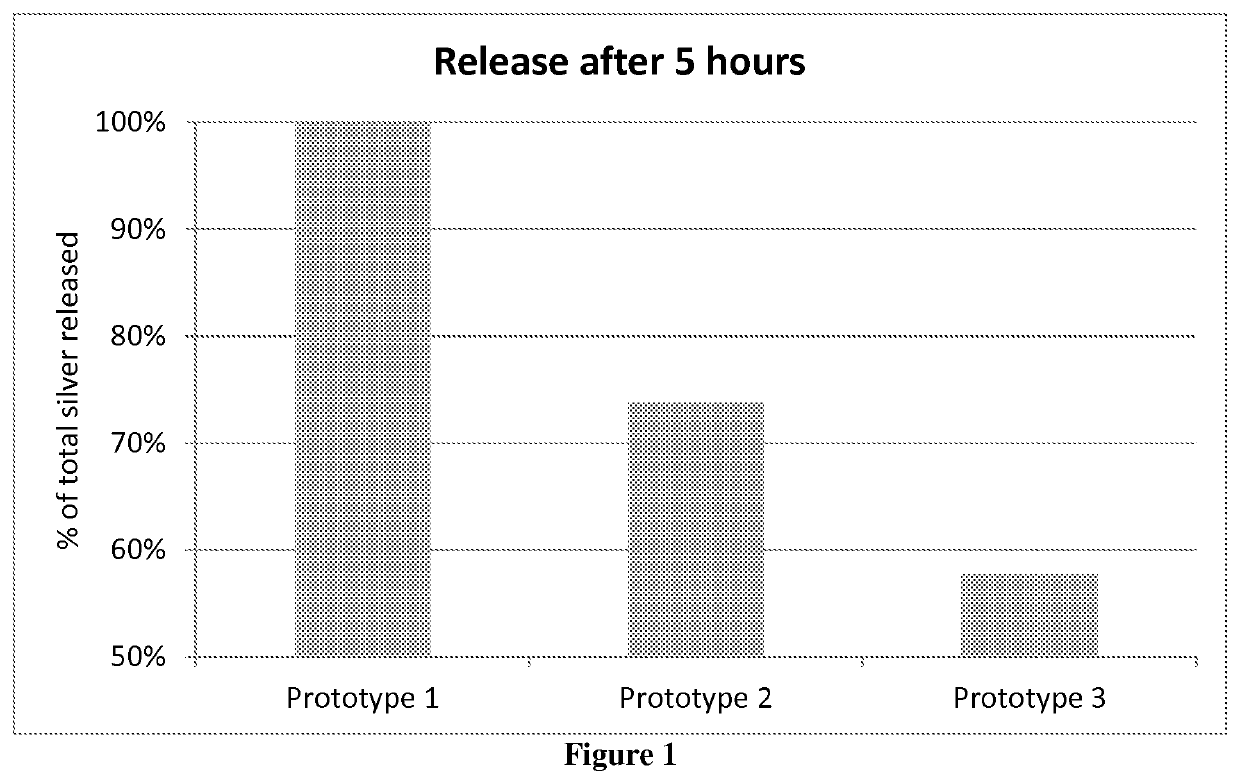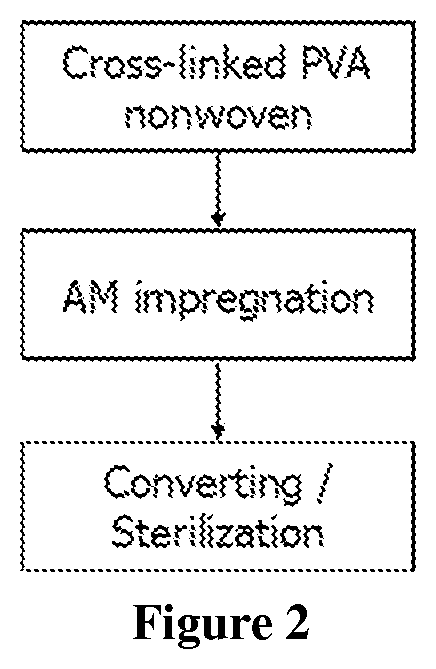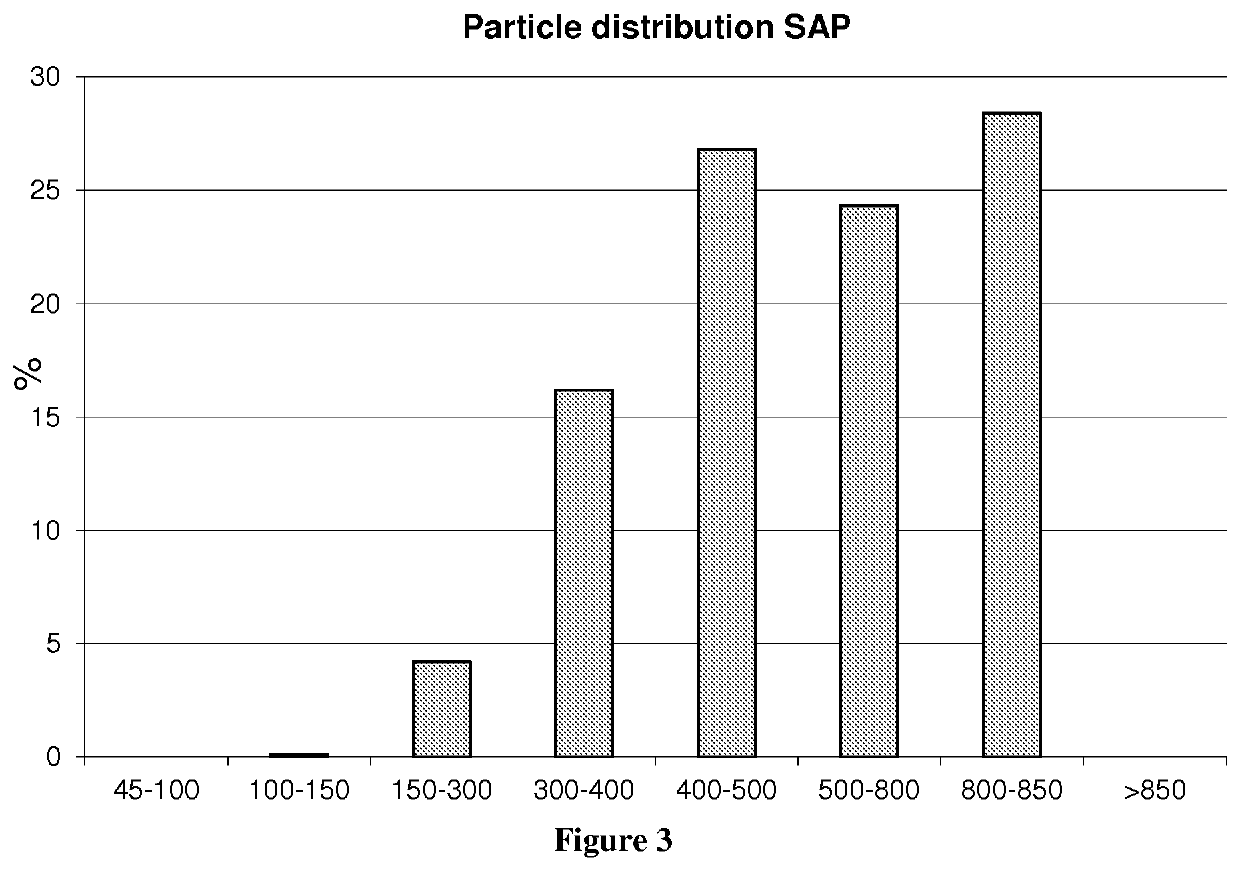Absorbent antimicrobial wound dressings
a wound dressing and antimicrobial technology, applied in the field can solve the problems of limited development of absorbent antimicrobial wound dressings, real challenges,
- Summary
- Abstract
- Description
- Claims
- Application Information
AI Technical Summary
Benefits of technology
Problems solved by technology
Method used
Image
Examples
example 1
on of Antimicrobial Coating Composition
[0058]Silver sulfate (3.6 grams; commercially available from Sigma-Aldrich) was added to 190 proof ethanol (of about 100 grams of total 300 grams) in a beaker after which the mixture was agitated at 11000 rpm for 10 minutes with a rotor / stator mixer. Water (35 grams, 10% w / w of total weight of the total mixture) at 65 degrees Celsius was added to hydroxypropyl cellulose (HPC, 4.3 grams; commercially available from Ashland) in a beaker and swirled around for a few seconds until an even mixture was obtained. The beaker was immediately mounted under an overhead stirrer equipped with a dissolver blade after which the stirrer was started. The ethanol / silver sulfate mixture was then carefully added to the beaker during mixing. The silver sulfate residuals were rinsed out into the beaker using the rest of the ethanol (approximately 200 grams). The combined ethanol / water / silver sulfate / HPC mixture was mixed for at least 60 minutes, increasing the mixin...
example 2
on to Substrate and Drying
[0059]The antimicrobial coating composition from Example 1 is coated onto a siliconized release paper (POLY SLIK® commercially available from Loparex). A substrate of non-woven (cross-linked PVA fibers; 250 gsm) (Exufiber® commercially available from Mölnlycke Health Care) was pressed against the antimicrobial coating on the release layer using a roller weight (2.2 kg) so that the antimicrobial coating was transferred into the non-woven substrate. After this the non-woven substrate was removed from the release paper and transferred onto a hot plate (80° C.) and dried for 2 minutes with the dry side facing the hotplate. The same procedure was then repeated for the other side of the non-woven substrate so that the product had been coated on both sides.
example 3
s for Testing
[0060]A number of prototypes, 1 to 8 as presented in Table 1 below, were prepared. Prototype 2 was prepared according to Example 1 followed by Example 2. Prototype 3 was prepared according to Example 1 and Example 2, but with the exceptions that different concentrations of HPC and / or silver sulfate were used as listed in Table 1. Prototype 1 including a silver coating with no HPC, was prepared by first preparing a silver coating composition according to Example 1 but with no added HPC, and subsequently the non-woven substrate (same as in Example 2) was dipped into the silver coating composition (consisting of a suspension of silver sulfate in ethanol), which silver coating composition was constantly stirred using a spatula in order to avoid sedimentation of the silver sulfate. The non-woven substrate was dried on a hot plate (80° C.) for about 10 minutes, until dried. Prototypes 4, 5 and 6 were prepared according to Example 1 and Example 2, with the following exceptions...
PUM
| Property | Measurement | Unit |
|---|---|---|
| molecular weight | aaaaa | aaaaa |
| pressure | aaaaa | aaaaa |
| pressure | aaaaa | aaaaa |
Abstract
Description
Claims
Application Information
 Login to View More
Login to View More - R&D
- Intellectual Property
- Life Sciences
- Materials
- Tech Scout
- Unparalleled Data Quality
- Higher Quality Content
- 60% Fewer Hallucinations
Browse by: Latest US Patents, China's latest patents, Technical Efficacy Thesaurus, Application Domain, Technology Topic, Popular Technical Reports.
© 2025 PatSnap. All rights reserved.Legal|Privacy policy|Modern Slavery Act Transparency Statement|Sitemap|About US| Contact US: help@patsnap.com



